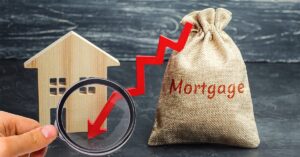Home prices have climbed substantially since bottoming out in 2012. The question at hand is whether these increases constitute a bubble that will inevitably break. One of the last things mortgage originators need is another housing bubble.
To understand just how much prices have increased, look to the Case-Shiller index, a composite index of 20 major metropolitan statistical areas and the most-often used metric to measure the prices of single-family homes in the U.S. This index is normalized to have a value of 100 as of January 2000.
It peaked at 206.7 in April 2006. After the housing- market crash, it fell to 140.8 in May 2009, then more or less stayed level for three years before reaching a trough of 136.6 in March 2012. It started climbing again at that point and reached 214.9 this past February.
Originators might worry that these price increases are unsustainable. What conditions could lead to another crash for both the housing market and overall U.S. economy?
Defining bubbles
Bubbles occur in many asset classes. A bubble happens when there is a relatively sudden increase in prices beyond the asset’s intrinsic value, which is followed by a price drop. Housing bubbles happen less often than equity or commodity bubbles, but they take longer to cure and cause broader damage to the overall economy.
The most obvious recent bubble is bitcoin and other types of cryptocurrency. Although cryptocurrency has no intrinsic value, its price was driven up by euphoria and greed. Once profit-taking set in and prices fell there were few greed-driven purchases. The decline in the price of bitcoin had little effect on the economy.
The last significant non-real estate bubble was the dot-com bubble of 1995 to 2000. In the dot-com bubble, people purchased shares of tech companies despite the fact that many had no idea what the companies did or made, who ran them or what the long-term prospects for these ventures were. People purchased company shares because they thought the prices would be higher in the near future.
Housing-bubble causes
Economists have long debated why bubbles form. For the sake of argument, let’s say there are three causes: bubbles caused by greed, ones that occur as part of the classic business cycle and others by regulatory failure. Two examples have already been mentioned: Greed sparked the dot-com and cryptocurrency bubbles.
In a classic business cycle, people see an opportunity and invest money because they see a profitable future. A recent example was the telecom crash of the early 2000s, which often is either overlooked or confused with the dot-com crash. Because the internet was seen as a place with a bright future, some companies spent massive amounts of capital on infrastructure to provide internet-access bandwidth. An oversupply of bandwidth led to large price reductions and subsequent bankruptcies. The telecom bubble was created by irrational exuberance.
The housing crisis of a few years later was arguably caused in large part by regulatory failure. The dubious securitization schemes of Wall Street investment banks are often blamed, but that overlooks the role of the U.S. Department of Housing and Urban Development (HUD). Federal-government policies dating to the early 1990s aimed to increase homeownership. To do so, HUD mandated the government-sponsored enterprises (GSEs) to buy larger and larger shares of mortgages made to low- and moderate-income borrowers.
Debt-ratio underwriting guidelines were loosened and, by 2000, the GSEs were buying zero-downpayment mortgages. Of the 31 million subprime mortgages that helped lead to the crash, 23.8 million were held by the GSEs or government agencies. Creating a housing bubble and recession was not the intention of the policies to increase homeownership. The purpose was to expand the social benefit of homeownership. The thinking was that homeownership creates social stability and wealth. The bubble was an unintended effect.
Undesirable effects
The biggest difference between a housing bubble and a bubble for other types of assets is the amount of leverage used in purchasing a home. Housing bubbles are built with borrowed money.
When the bubble started bursting in 2007, the entire banking system was put at risk. Banks no longer trusted one another and a liquidity crisis ensued. The liquidity crisis was addressed by a series of provisions from the Federal Reserve.
Another problem was that with a substantial portion of many banks’ assets now illiquid, it was essentially impossible to determine whether a bank was solvent. One cannot mark to market (or fairly measure the value of) securities when there are no buyers. The issue of banking solvency was addressed by the Troubled Asset Relief Program, or TARP, which provided banks with temporary equity that enabled them to remain solvent.
Housing bubbles last longer because real estate is much less liquid than other assets and, thus, recovery to price stability is drawn out. These bubbles have another undesirable effect: Since mortgage payments and rents consume such a large portion of household income, these bubbles adversely affect discretionary spending and the economy in general.
Lack of supply
Bubbles are inevitable only to the extent that human greed and foolishness create them. So, yes, bubbles are inevitable. How does this relate to large gains in home prices?
In the past few years, there have been significant increases in home prices in many cities. The reason this has happened is different from the pre-2007 bubble. Recent price increases have been caused by a lack of supply. Supply is restrained by land-use regulations, especially zoning. In many places, jobs have been created without adding housing supply.
Little discussed is the fact that many cities do not want more housing. There are two reasons for this: The not-in-my-backyard crowd, or people who don’t like development around them, and the less-discussed fact that new housing is often revenue neutral to a city. Although added housing increases total property-tax receipts, adding residents costs local governments money, creating the need for more schools, police and other services.
A better balance
So, what does this all mean for mortgage originators? The real estate market is likely transitioning to one with a better balance of buyers and sellers, as well as flatter prices. A crisis like what happened in 2007 is unlikely to occur. Local prices could drop in cities where jobs are lost or where speculation took place.
Although the last recession was caused by plummeting home prices, it is usually recessions that cause home-price declines. Economic growth is likely to slow to the range of 1.75 percent to 2.25 percent annually, but the probability of a recession is not yet significant. Housing starts have been below the 1.5 million level required to accommodate the demands of increased population, as well as aging homes that are scrapped or those damaged by disasters.
Consequently, there is no oversupply. The homeownership rate has reverted to where it was in 1995. The last year there were more than 1.5 million starts was 2006. Single-family starts have been particularly weak and are below the average from 1960 to 1990. From 2008 through 2018, housing starts averaged 919,000 units per year, including 635,400 single-family starts on average. Over the past 20 years, however, total starts averaged more than 1.2 million.
A relatively new factor in the single-family home market rose in the post-recession period — large-scale corporate ownership of single-family residences. As of 2017, there were at least six companies that owned more than 10,000 single-family homes, according to Amherst Capital. Assuming this business model continues, it might provide a cushion for housing if there is a downturn.
A possible cause of another housing bubble could be the same as the last one — a government mandate to make loans to people who cannot afford the payments. There is some early indication of this activity, with the weakening of credit standards for conforming loans. The GSEs now make loans to borrowers with a 620 credit score. In addition, the credit-score models have changed, with the effect that many credit scores are now higher.
Twenty-five percent of Federal Housing Administration (FHA) purchase loans closed in 2018 had debt-to-income ratios above 50 percent. The average credit score for an FHA loan in 2018 was 670 — the lowest figure since 2008. Thirteen percent of FHA forward-mortgage endorsements for 2019 had credit scores below 620. Fannie Mae and Freddie Mac lowered their borrower waiting period following a bankruptcy, pre-foreclosure or short sale from four years to two.
• • •
The lowering of credit standards is happening for many of the usual reasons — interest groups understand politics and politicians have little regard for any future downside risks, instead preferring short-term benefits. If the government wants to achieve the short-term benefits that result from less stringent lending standards, with little regard for risk, there is little to stop them.
Author
-

Dick Lepre is a loan agent for CrossCountry Mortgage LLC. He has been in the mortgage business since 1992 and has been writing a weekly email newsletter on macroeconomics, mortgages and housing since 1995. Lepre (NMLS No. 302379) is from New York City, but he has lived in the San Francisco Bay Area since 1968. He has a degree in physics from Notre Dame. Follow him on Twitter @dicklepre.
View all posts






